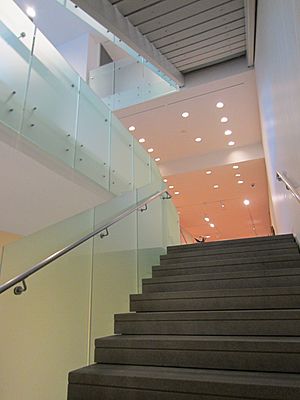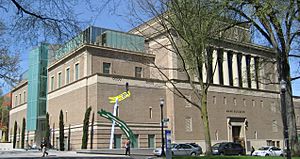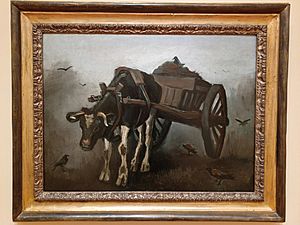Portland Art Museum facts for kids

The Portland Art Museum in 2019
|
|
| Established | 1892 |
|---|---|
| Location | 1219 SW Park Avenue Portland, Oregon, U.S. |
| Type | Art museum |
| Accreditation | American Alliance of Museums |
| Visitors | 445,000 (2002) |
| Public transit access |
|
The Portland Art Museum (PAM) is a cool place to see art in downtown Portland, Oregon, USA. It's one of the oldest art museums on the West Coast. The museum has a huge space, with over 112,000 square feet (10,400 m2) just for showing art!
PAM is home to more than 42,000 pieces of art. You can explore special areas like the Center for Native American Art and the Center for Northwest Art. There's also a section for modern and contemporary art, and beautiful Asian art. Outside, you'll find a public sculpture garden. The Northwest Film Center, which shows movies and teaches about filmmaking, is also part of the museum.
The museum is officially recognized by the American Alliance of Museums. This means it meets high standards for how it cares for its art and serves the public.
Contents
How the Museum Started
The Portland Art Museum began in 1892. It was first called the Portland Art Association. Seven important business and cultural leaders in Portland wanted to create an art museum for their growing city.
A man named Henry Corbett gave $10,000 to help start the museum. This money bought the museum's first collection, known as the Corbett Collection. It included one hundred plaster copies of ancient Greek and Roman sculptures. Winslow B. Ayer and his wife chose these pieces during a trip to Europe. Experts from the Metropolitan Museum of Art helped them decide what to pick. The collection was first shown at the Multnomah County Library.
The Early Years
By 1905, the museum needed more space. It moved into its own building at SW 5th and Taylor streets. The first show in this new building featured watercolors and paintings. These artworks had come to Portland for the Lewis and Clark Centennial Exposition. Henrietta H. Failing, a curator, organized this show with artist Frank DuMond.
In 1908, the museum bought its first original painting. It was Afternoon Sky, Harney Desert by Childe Hassam. He was an American painter who loved visiting Eastern Oregon.
Anna Belle Crocker became the curator in 1909. She was a very important person in the museum's early days. She also led the Museum Art School, which opened in 1909. Today, this school is known as the Pacific Northwest College of Art.
In 1913, the museum held a very important exhibition. It showed artwork that had been in the famous 1913 New York Armory Show. This show introduced Americans to modern art. The exhibition included works by famous artists like Cézanne, Van Gogh, Gauguin, Matisse, Manet, and Renoir. It even featured the famous and talked-about painting Nude Descending a Staircase, No. 2 by Marcel Duchamp.
The museum kept growing after World War I. In the 1920s, Sally Lewis, from a well-known Portland family, organized two special shows. She knew many famous artists from her travels. In 1923, she put together a show with 44 paintings by Picasso, Matisse, André Derain, and American modern artists. She also helped the museum buy Derain's Tree for its collection. Her second show in 1924 was even bolder. It showed European paintings and drawings next to African masks. This show included Brâncuși's A Muse, which Lewis later gave to the museum.
A New Home for Art
The museum's current main building opened on November 18, 1932. It is located at SW Park Avenue and Jefferson Street. The famous architect Pietro Belluschi designed the building. It sits along Portland's South Park Blocks and is a key part of the city's Cultural District.
Winslow B. Ayer, who helped choose the first plaster casts, gave $100,000 for this new building. That's why the original part of the building is called the Ayer Wing. Belluschi's design was modern. It had a simple outside look. He believed the building's design should highlight the art inside, not the building itself.
In 1938, the museum became a nonprofit organization. This meant it could focus on its mission without making a profit.
That same year, work started on a new part of the museum. This was the Hirsch Wing, also designed by Belluschi. It was paid for by a gift from Ella Hirsch. The new wing opened on September 15, 1939. It doubled the amount of space the museum had to show art.
Growing After the War
In 1942, the Portland Art Museum celebrated its 50th birthday quietly because of World War II. But in 1943, the staff counted all the art. The museum had 3,300 artworks in its permanent collection.
The next ten years brought many popular art shows. In 1956, almost 55,000 people visited a show of paintings from Walter Chrysler's collection. This show started in Portland and then traveled to nine other cities. In 1959, over 80,000 people came to see a Vincent van Gogh exhibition. The money from this show helped the museum buy a Water Lilies painting by Claude Monet from 1915. Also in the 1950s, the museum started its Docent Council in 1955. These volunteers still help the museum today.
In the 1960s, the museum added another big section, the Hoffman Memorial Wing. It was named after L. Hawley Hoffman, who was president of the museum twice. This new wing was built with money from the museum's first big fundraising effort. Construction started in 1968 and finished in 1970. Pietro Belluschi was the architect again. This expansion added classrooms, studio space, a sculpture area, a new vault for art, and an auditorium.
Over the next few decades, the museum's art collections and programs continued to grow. In 1978, Vivian and Gordon Gilkey started working with the museum. They brought a huge collection of thousands of artworks on paper. This led to the opening of the Vivian and Gordon Gilkey Center for Graphic Arts in 1993. Also in 1978, the Northwest Film Center joined the museum. It offers film festivals, classes, and programs about movies.
The Museum Today
In 1992, the Portland Art Museum bought the building next door, which used to be a Masonic Temple. The museum then raised money to update its main building. This project improved the art galleries and added a climate control system to protect the art. After the updates, PAM hosted Imperial Tombs of China. This show brought 430,000 visitors to the museum!
PAM renovated the former Masonic Temple and renamed it the Mark Building. It opened to the public in 1995. This building now holds the Jubitz Center for Modern and Contemporary Art. This center has six floors and covers 28,000 square feet (2,600 m2). The Mark Building also has the Crumpacker Family Library, meeting rooms, ballrooms, and offices.
A big renovation of the Hoffman Wing finished in 2000. This added over 50,000 square feet (4,600 m2) of new gallery space. It included the Grand Ronde Center for Native American Art and the Arlene and Harold Schnitzer Center for Northwest Art. This renovation cost $45 million.
In 2001, PAM bought a private collection of 159 artworks from art critic Clement Greenberg. These works were by artists like Kenneth Noland, Jules Olitski, and Anthony Caro.
In 2007, the museum received Vincent van Gogh's 1884 painting The Ox-Cart as a gift.
In December 2013, Francis Bacon's Three Studies of Lucian Freud was shown for three months. It had just been sold at an auction.
In 2016, the Portland Art Museum announced plans for a new glass-walled addition. This addition, called the Rothko Pavilion, will connect its two main buildings. This project is a partnership with Mark Rothko’s children. They will lend important Rothko paintings from their private collection to the museum for the next twenty years.
The museum has recently added photographs, negatives, and color pencil sketches by Los Angeles photographer Ray McSavaney.
Today, the Portland Art Museum has a collection of over 50,000 objects. Brian Ferriso became the museum's director in 2006.
Amazing Art to See
The museum has a collection of over 40,000 artworks. Here are just a few of the amazing pieces you can find there:
- Castel Gandolfo by George Inness – in the American Art Collection.
- Mount Hood by Albert Bierstadt – also in the American Art Collection.
- The finding of Moses (around 1730) by Giambattista Pittoni.
- Arrival of the Westerners by Kano School (from the Edo period in Japan) – in the Asian Art Collection.
- Paris: Quai de Bercy — La Halle aux Vins by Paul Cézanne – in the Modern and Contemporary Art Collection.
- Water Lilies by Claude Monet – also in the Modern and Contemporary Art Collection.
- The Prince Patutszky Red by Jules Olitski – in the Modern and Contemporary Art Collection.
- Seine at Argenteuil by Pierre Renoir.
- River at Lavacourt by Claude Monet.
- The Ox-Cart by Vincent van Gogh.
- Nativity by Taddeo Gaddi.
- Madonna and Child by Cecco di Pietro.
- Allegory Figure of Woman by Franz Von Stuck.
- Top of The Town by Roger Brown.
- A Muse by Constantin Brâncuși.
- Likunt Daniel Ailin (The World Stage: Israel) by Kehinde Wiley.
- FamilyTreePiles by Nan Curtis.
- Nude with Beads (Frida Kahlo) by Diego Rivera.
Art Awards and Shows
The Oregon Biennial used to be an art exhibition held every two years at PAM. In 2007, it was replaced by the Contemporary Northwest Art Awards (CNAA). This show also happens every two years. It features artists from Oregon, Washington, Idaho, Wyoming, and Montana. One artist from the CNAA show wins the $10,000 Arlene Schnitzer Prize.
The Crumpacker Art Library
The Crumpacker Family Library started with the museum in 1892. It has over 40,000 books and other items about art.
More to Explore
- List of largest art museums




